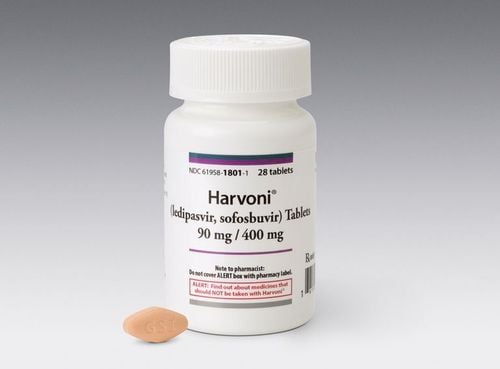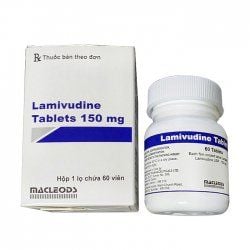This is an automatically translated article.
Larevir 100 is the preferred drug class indicated for the treatment of symptomatic relief of chronic hepatitis B, HIV infection. So what is Larevir 100 drug? Is Klavunamox a mild or severe antibiotic? What diseases does Larevir 100 treat? The following article will help you better understand the uses of Larevir 100.
1. What are the uses of Larevir 100?
1.1. What is Larevir 100? Larevir 100 is a drug used in the treatment of chronic hepatitis B, with the active ingredient being Lamivudin. One Larevir 100 tablet has the main ingredient Lamivudin: 100mg, in addition to other excipients, just enough for 1 tablet, made in the form of film-coated tablets, packed in boxes of 10 blisters, each blister has 10 tablets.
1.2. What is Larevir 100 used for? Each type of pharmaceutical product is manufactured with a primary purpose of being used to treat a specific disease or condition. That is why Larevir 100 should only be used to treat the conditions or conditions specified in the instructions for use. Although Larevir 100 may have some other effects that are not listed on the approved label, patients should only use this drug to treat certain other conditions when prescribed by a specialist. department.
Larevir 100 is effective in the treatment of liver enzymes serum ALT 2 times higher than normal, cirrhosis, necrotizing inflammatory liver disease shown on biopsy, immunodeficiency, liver transplantation, and combination in treatment of HIV infection.
2. Usage of Larevir 100
2.1. How to take Larevir 100 Each drug or pharmaceutical product is manufactured in a form corresponding to different dosage forms and routes of administration. Common routes of drug administration are classified by drug form: drugs for oral administration, drugs for injection, drugs for external use and drugs for suppositories.
Patients should carefully read the instructions on how to take Larevir 100 listed on the instructions for use of the drug, do not arbitrarily use the drug by other routes not listed on the instruction sheet of Larevir 100.
Patients Take the medicine before, during or after eating. When taking, the patient should not chew the tablet, take it whole with filtered water or boiled and cooled water.
2.2. Dosage of Larevir 100 Children over 12 years old and adults: Recommended dose: 100 mg x 1 time a day. The drug should be discontinued in patients with a normal immune response when an HBeAg or HbsAg seroconversion response occurs. Children under 12 years: 3 mg per kg x 1 time per day, (maximum 100 mg per day) HIV infection:
People 16 years of age and older. Weight more than 50 kg: 150 mg Lamivudine and 300 mg Zidovudine every 12 hours. Weight less than 50 kg: 2 mg Lamivudine per kg body weight and 4 mg Zidovudine per kg body weight, every 12 hours. Children from 12 years old to 16 years old. Weight more than 50kg: 150 mg Lamivudine and 300 mg Zidovudine, every 12 hours. Weight less than 50 kg: there are no adequate data to guide the dose. Children 3 months to 12 years of age: 4 mg Lamivudine per kg every 12 hours, up to a maximum dose of 300 mg Lamivudine daily. Patients with renal impairment : Dosage reduction is required. Creatinine clearance (ml per minute). Dosage Lamivudine (for people 16 years of age and older) Weight 30 to 49 kg: 150mg, once a day Weight 15 to 29 kg: 150mg on the first day; days after 100mg, once a day. Weight 5 to 14 kg: First day 150mg; the following days 50 mg, once a day. Under 5kg: First day 50mg; the following days 25 mg, once a day. With doses over 100mg this dosage form is not suitable. Chronic hepatitis B:
Adults: 100mg, once a day. Children over 2 years old: 3mg per kg, once a day; up to 100 mg per day. Patients with renal impairment: The dose must be reduced as directed by the physician. Patients infected with HIV and hepatitis B virus simultaneously: Use according to HIV antiretroviral dose.
Note, the patient should take the medicine at a certain time to avoid forgetting the dose; If you miss a dose, you need to skip the missed dose, do not overlap the dose, double the dose with the next dose.
In addition, very little is known about overdose, although no clinical signs or symptoms have been observed in overdose, and blood tests are normal. There is no antidote for an overdose. It is not known if Lamivudine is eliminated by peritoneal dialysis or hemodialysis.
In case an overdose occurs, suggest that the patient immediately go to the nearest medical facility so that medical staff can have appropriate treatment methods.
3. Contraindications of Larevir 100
Patients who are sensitive to the ingredients of the drug 3.1. Other drug interactions Zidovudine plasma concentrations are significantly increased (approximately 39%) when co-administered with Lamivudine. Trimethoprim/Sulfamethoxazole increased the bioavailability of Lamivudine (44%) as measured by the area under the concentration-time curve (AUC), and decreased renal clearance (30%). Although AUC was not significantly affected, absorption of Lamivudine was slowed and peak plasma concentrations were 40% lower when the drug was administered on full stomach than when the drug was administered on an empty stomach. 3.2. Pregnancy and breast-feeding Pregnancy: Larevir 100 can be administered to a pregnant woman, especially when there is a chance of protection from infection to the fetus. In case of using Lamivudine in combination with oral administration (Lamivudine and Zidovudine tablets), avoid using it in pregnant women. Lactation: Although it is not known whether Lamivudine is excreted in human milk, there is a potential for undesirable effects due to Lamivudine in breastfed infants. There is also a high risk of HIV transmission through breastfeeding, and HIV-infected mothers should not breastfeed.
4. Note when taking Larevir 100
With caution in patients with metabolic acidosis due to accumulation of lactic acid which may be accompanied by severe liver disease and fatty liver disease. Closely monitor during treatment with Larevir 100 for possible inflammation. Recurrence of the liver due to a mutated HBV virus that is desensitized to lamivudine Closely monitor patients with hepatitis B who have discontinued Larevir 100 therapy, with particular attention in patients with decompensated cirrhosis due to possible relapses. return disease Use with caution in children and adolescents, patients with HIV, people receiving immunosuppressive therapy or cancer patients undergoing chemotherapy, drivers and operators Larevir 100 is not harmful to the fetus, so it can be used in pregnant women, however, it is necessary to consider discontinuing the drug during pregnancy due to the possibility of recurrence of hepatitis. The potential and benefits of using Larevir 100 to treat lactating women During the time of using the drug, patients absolutely follow Incubate according to the dosage instructions of the treating doctor, avoid increasing or decreasing the dose to speed up the treatment time. Before stopping using the drug, the patient should consult the treating doctor. again. Medicines should be stored in a dry place, with moderate humidity and away from direct sunlight. Keep away from children's play areas, to prevent children from taking the medicine without knowing it.
5. Side effects of Larevir 100
5.1. Common side effects Nervous system: Headache, dizziness, fatigue, paresthesia, insomnia, high fever, chills, musculoskeletal pain, peripheral nerve pain Endocrine system: Allergies, rash Respiratory system: Nose, throat problems Circulatory system: Anemia, decreased number of neutrophils Digestive system: Liver has elevated liver enzyme AST 5.2. Uncommon side effects Gastrointestinal system: Pancreatitis, liver increased blood bilirubin levels Circulatory system: Decreased platelet count During the treatment, the patient noticed any abnormality that was suspected to be due to When using Larevir 100, patients need to consult a pharmacist or treating doctor for timely and accurate treatment.
6. How to store Larevir 100
Concentration, content, active ingredients of the drug are affected if the drug is not stored well or when the expiry date is expired, leading to harm to the patient when using.
Carefully read the information on storage and expiry date of the medicine listed on the product packaging and the drug instruction sheet before using. Usually medicines are stored at room temperature, away from moisture and direct light.
When the medicine is out of date or cannot be used, consult your doctor, pharmacist or garbage disposal for a safe way to dispose of the medicine. Medicines should not be thrown down the toilet or plumbing unless asked to do so.
Note: Do not keep Larevir 100 out of the reach of children and away from pets.
Before taking Larevir 100, it is necessary to double check the expiry date indicated on the product packaging, especially with medicines that are stored at home.
Please dial HOTLINE for more information or register for an appointment HERE. Download MyVinmec app to make appointments faster and to manage your bookings easily.
Reference source: drugbank.vn












